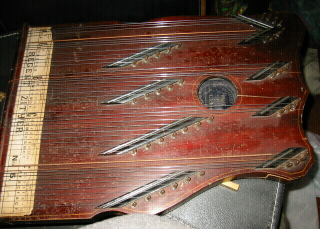|
|
|
|
These zithers are beautiful and mysterious. I see them occasionally on Ebay, but haven't been able to find out a single thing about them. My two vary in size, color and quality, but are instantly identifiable as Regent zithers by the sinuous curves of the top and the distinctive inverted V-shaped arrangement of the tuning pegs. In a general way, they resemble the Menzenhauer zithers (although they do not reference his patent). Each zither is tuned to a single key, and chord strings are arranged into open chord groups. Across the bottom is a paper label identifying strings by note and number.
|
|
Perfection Zither "Regent" 5 A. Eichler 33 First Street, New York |
 |
|
|
|
|
But at this point, the similarity to the rest of the chord zithers ends
abruptly. The chord groups range from the usual 4 strings to as many as
10! And there are no melody strings. My first thought was that the
instrument was intended for accompaniment only, like an autoharp. But on
more careful examination I realized that something more subtle was going
on. For instance, there seem to be too many notes in the 2nd chord group
from the right. And why are some of the strings labeled with numbers, but
not all of them? .
|
The answers to both of these questions can be found in the battered label from the smaller zither. There are two octaves of carefully numbered melody notes hidden within the chord groups! I'm quite sure that these were intended to be played as melody strings. The clue is that the 6th note of the scale - the only one that does not occur naturally in the top 2 chords - has been explicitly identified in the lowest chord and actually inserted into the 2nd chord, where it doesn't belong. |
It turns out to be remarkably easy to play a melody on this string arrangement once you get used to it. I use my right hand to pluck the strings in the top chord (the tonic), and my left hand to pluck the rest of the notes out of the second chord. I put a thumb pick on one hand and use it to hit that lower C# (6). Any time I feel like it, I strum the notes below the melody note in the same chord group. Sometimes I don't play a song at all, I just strum across all the chord groups, going very slowly through the middle chord to savor the oddness of that out-of-place, but not really dissonant, C#, before resolving to the final perfect chord (I'm easily amused, musically).
Anyway, that's how I play the little Regent #3. It quickly became one of my favorites to play; it's small enough that you can hold it in practically any position, but has a full sweet sound. Its larger cousin I haven't quite mastered yet. It's too big to hold in my lap, and I'm not quite sure what to do with all those additional chords.
I wish I knew more about this remarkable family of zithers. Every other chord zither I have ever seen is in the key of C or (less commonly) G. But my Regent zithers are in the oddball keys of E and F! Were they like harmonicas, available in every key? Why? A musician carrying around a bag of harmonicas in multiple keys is one thing - but who would cart around a pile of chord zithers? Remember, these things were made in the days before electronic tuners!
|
|
|
|
Zither Home |
Site Last Updated April
21, 2002
By Sharon
Kahn